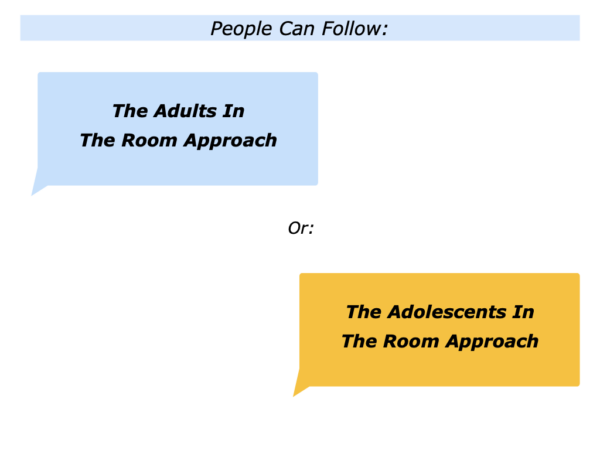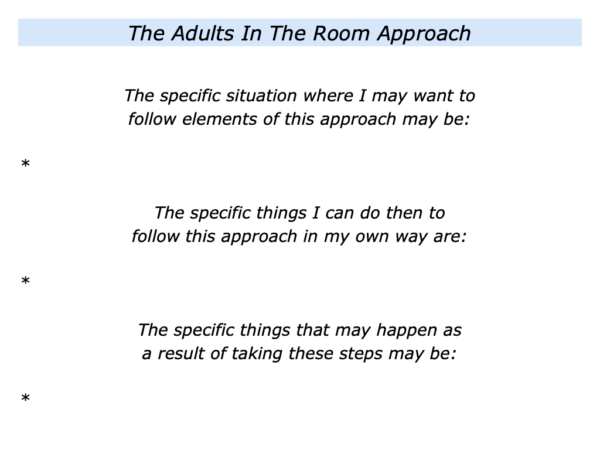
Different people work in different ways. Some people act like responsible adults. They aim to be respectful and do their best to deliver the desired results. They follow the old rule of acting like adults in the room.
Some people take another route and act like irresponsible adolescents. They are disrespectful and focus on delivering noisy rhetoric that gets them noticed. This can create collateral damage and chaos.
Different people follow these approaches in different ways. Let’s explore these themes.
The Adults In
The Room Approach
Some organisations ensure that the leadership team and other teams have people who behave like adults. The phrase adult in the room has several definitions. These include the following:
A person or a group of people that behaves in a mature and responsible ways. They also make measured and rational decisions based on all the available facts and data.
People who behave in this way often display the following characteristics when making decisions, doing the work and in their interactions with other people.
They Take Responsibility
Such people choose to take responsibility. They enjoy being proactive, looking ahead and anticipating challenges. They like to make things happen but are also good at responding to events.
They enjoy making considered decisions. They clarify the real results to achieve, the possible ways forward the consequences of each option. They then focus on how to build on the pluses and minimise the minuses of pursuing their chosen option.
They Show Respect
Good leaders behave in a professional way and show respect to other people. Nelson Mandela, Mary Robinson and many other fine leaders demonstrated this quality in abundance.
They are decisive but also believe in building caring and civilised cultures. They are respectful when meeting people and, when appropriate, listening to their points of view.
They Deliver Results
People who act like adults aim to deliver the desired results. Bearing in mind the aims to achieve, they follow the strategies most likely to achieve success and deliver consistently high professional standards.
They embody the concept of continuous improvement and find solutions to challenges. They do what they promise to do and do their best to achieve the agreed picture of success. Sometimes they also add that touch of class.
The Adolescents In
The Room Approach
Some organisations lapse into employing or even promoting people who behave like irresponsible adolescents. They may have a leadership group of individuals who compete against each other, blame people or engage in turf wars.
People who behave in this way can have a corrosive effect on the culture and create collateral damage. Such individuals sometimes demonstrate the following characteristics.
They avoid taking responsibility. They blame other people, outside events or other factors. They praise their own efforts – sometimes even awarding themselves big bonuses – and present themselves as victims.
They do not show respect for other people. They may see themselves as superior or even scapegoat others. The way they behave can contribute to building a cruel and uncaring culture.
Such individuals are more interested in rhetoric – including proclaiming their views loudly – than delivering the desired results. Some pick fights or promote themselves rather than doing the job for which they were hired.
Let’s return to your own life and work. Looking ahead, can you think of a situation where you may want to follow elements of the adults in the room approach?
This could be a situation where either you want: a) to be an adult yourself; b) to gather a team of people who play that role; c) to promote somebody who acts like an adult.
If you wish, try tackling the exercise on this theme. This invites you to complete the following sentences.







Leave a Reply